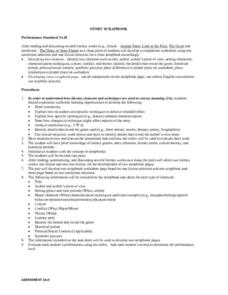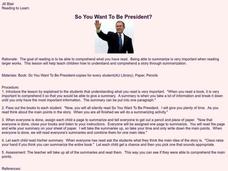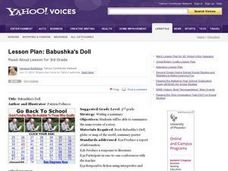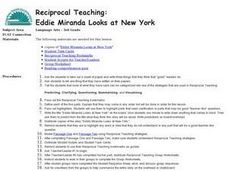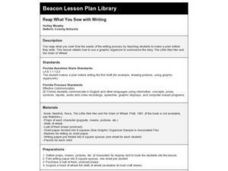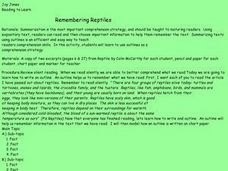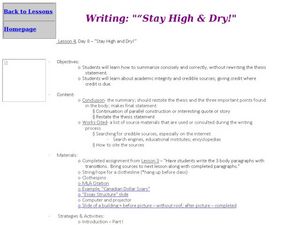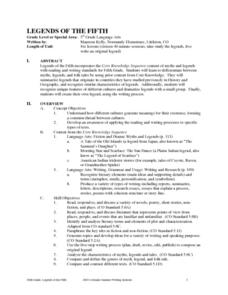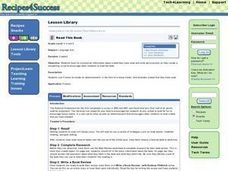Curated OER
Story Scrapbook
Students develop a comparison worksheet using one non fiction book and one fiction book they have read to be put into a class scrapbook. In their comparison students must have title, author, point of view, setting, characters, and other...
Pennsylvania Department of Education
Stories? Information? What's the Difference?
Students listen to a power point presentation to distinguish between fiction and nonfiction text. In this what's the difference lesson plan, students identify fact from opinion within a text. Students listen critically and respond to text.
Curated OER
Reviewing Literary Elements
Learners identify the elements of fiction, and work on compare and contrast skills.. In this comprehension lesson plan, students read different versions of Cinderella. Learners use a Venn diagram to compare and contrast the literary...
Curated OER
Five Big W's
Students develop summarization strategies by asking themselves questions as they read. They devlop these strategies help them develop better comprehension. Students goals for reading is comprehension. They explore helpful...
Curated OER
So You Want to be President?
Students review the meaning of a summary and why they are important. They silently read the book, So You Want To Be President thinking about the main points in the story. When finished, each child summarizes a page from the book which...
Curated OER
Babushka's Doll
Third graders read the story Babushka's Doll and write a summary of the main events in the story. In this summaries lesson plan, 3rd graders discuss the country of Russia before they read.
Curated OER
Sum It Up
Students write summaries of books to exemplify comprehension of the stories. They create a story web to outline the important details of the story. In groups, students make story webs for separate chapters for the book. After the webs...
Curated OER
Nasreddin and the Pot Exercise 3
In this Nasreddin and the Pot learning exercise, students read the story Nasreddin and the Pot and fill in the blanks to the summary. Students fill in the blanks for 8 sentences.
Curated OER
Nasreddin and the Beggar Exercise 3
In this Nasreddin and the Beggar worksheet, 2nd graders read the story Nasreddin and the Beggar and fill in the blanks to a summary about it. Students fill in 10 blanks.
Curated OER
Reciprocal Teaching: Eddie Miranda Looks at New York
Third graders use the strategies in Reciprocal Teaching: predicting, clarifying, questioning, summarizing, and visualizing. They utilize these reading strategies when reading "Eddie Miranda Looks at New York."
Curated OER
Reciprocal Teaching: The Migrants
Fourth graders use techniques involved in Reciprocal Teaching: predicting, clarifying, questioning, summarizing, and visualizing. They use these reading strategies while reading "The Migrants."
Curated OER
The Three Little Pigs
Students listen two versions of the story of The Three Little Pigs in order to clarify the concept of point of view. They complete a Venn diagram and write a postcard to one of the book's characters using their point of view.
Curated OER
"Thunder Butte"
Sixth graders review as a class the story "Thunder Butte". Together they write an outline of the story following the sample and then pick four main parts of the story giving supporting details for each one. They compare Sarah's view with...
Pennsylvania Department of Education
Using Literary Elements to Compare Fiction Texts
Learners explore language arts by reading and reflecting on literary examples. For this fiction writing lesson, students read several different cultural versions of the story "Cinderella" and discuss their interaction with the story and...
Curated OER
Leaders of the Past
Fourth graders read a story about the life of Martin Luther King Jr. and summarize the story by filling in the blanks about his life on a storyboard handout. They listen to the "I have a dream" speech and write about how they feel life...
Curated OER
Reap What You Sow with Writing
Students practice using graphic organizers to summarize The Little Red Hen and the Grain of Wheat.
Curated OER
Outline of a Legend/Folk Tale
Students create outlines of folk tales and legends. They read a folk tale or legend in the target language. They complete an outline of the key events of the story including the main characters, plot, story elements and theme or moral.
Curated OER
Reading Response Log
In this reading response log worksheet, 3rd graders summarize what they have read. Using the prompts, students complete 6 short answer questions about their story.
Curated OER
Remembering Reptiles
Young scholars will learn to use outlines as a comprehension strategy. Summarization is the most important comprehension strategy, and should be taught to maturing readers. During this lesson learners use the story of a reptile to...
Curated OER
Outlining Essays (Grades 3-6)
Students brainstorm story idea in preparation of writing an expressive essay. They study how to outline essays to assist them in writing an expressive essay. Each students conclusion should summarize their main idea and restate their...
Curated OER
Writing: Stay High and Dry
Students write an effective conclusion for their essay. In this conclusion instructional activity students restate the thesis of their paper and summarize three important points. Students then write a final statement to wrap...
Curated OER
Legends of the Fifth
Fifth graders discover the difference between myths, legends, and folk tales. They summarize legends. They work together to dramatize legends and then create their own legend using the writing process. Handouts and worksheets are included.
Curated OER
Read This Book
Learners practice summarizing a story that they have read. They write a persuasive essay encouraging others to read the story they have finished. They are to create a movie trailer or advertisement to promote the book.
Curated OER
Health Education: Germs
Second graders examine germs. In this personal health lesson plan, 2nd graders summarize the methods for preventing the spread of germs through food, water, air, and touch.
